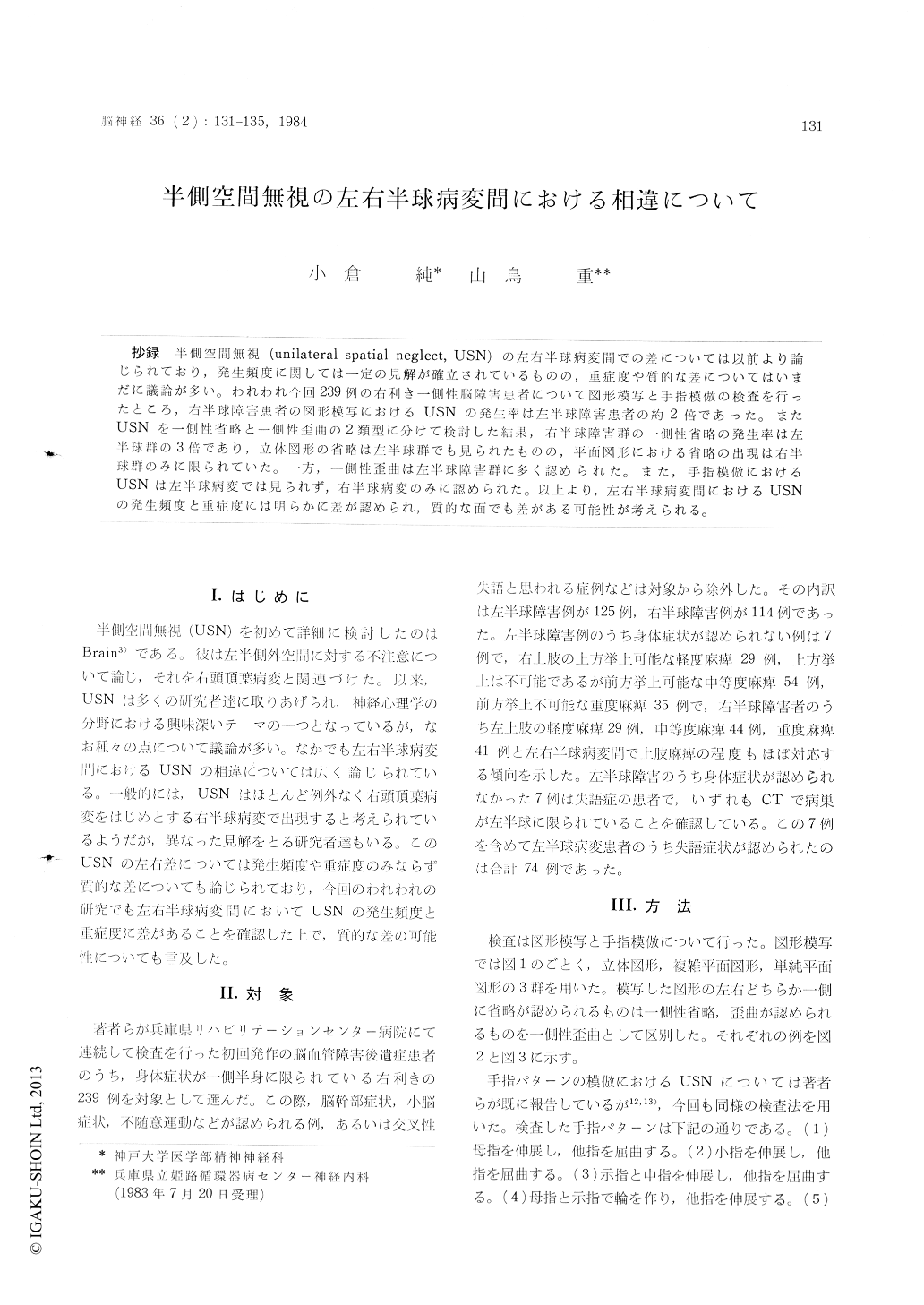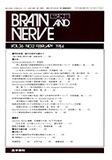Japanese
English
- 有料閲覧
- Abstract 文献概要
- 1ページ目 Look Inside
抄録 半空間無視(unilateral spatial neglect, USN)の左右球病変間での差については以前より論じられており,発生頻度に関しては一定の見解が確立されているものの,重症度や質的な差についてはいまだに議論が多い。われわれ今同239例の右利き一側性脳障害患者について図形模写と手指模倣の検査を行ったところ,右半球障害患者の図形模写におけるUSNの発生率は左半球障害患者の約2倍であった。またUSNを一側性省略と一側性歪曲の2類型に分けて検討した結果,右半球障害群の一側性省略の発生率は左半球群の3倍であり,立体図形の省略は左半球群でも見られたものの,平面図形における省略の出現は右半球群のみに限られていた。一方,一側性歪曲は左半球障害群に多く認められた。また,手指模倣におけるUSNは左半球病変では見られず,右半球病変のみに認められた。以上より,左右半球病変間におけるUSNの発生頻度と重症度には明らかに差が認められ,質的な面でも差がある可能性が考えられる。
Many investigators were interested in unilateral spatial neglect (USN) and studied it in various respects. Especially the between-hemispheric dif-ference of USN has been broadly argued. It can be considered as a well accepted fact that there is a difference of frequency of USN between left and right brain-damaged patients, however, there is no consistent opinion whether there are diffe-rences of severity and quality. To settle this dis-pute, 239 right-handed unilateral brain-damaged subjects were investigated on USN. 125 subjects suffered from left hemisphere lesions and 114 from right hemisphere leesions. Two tests ; copy of draw-ings and finger imitation ; were performed. On copying of drawings, each patient was required to copy line drawings of cubes, complex two-dimen-sional geometrical figures and simple two-dimen-sional geometrical figures. Those who failed tocomplete either the left- or right-hand side of any one of these drawings were classified as showing USN. Then failures of USN were divided into two different patterns ; unilateral omission and unilateral distorsion. Again imitation of various finger patterns was tested with the hand homola-teral to lesions. These items were presented by two methods. The subjects saw the dorsal side of the examiner's hand in the first, and palmar side in the second.
On the copying of drawings, right brain-dama-ged subjects had about twice higher incidence of total USN than left brain-damaged subjects. As for omission alone, the incidence with the right hemispheric group was three times as high as the incidence with the left hemispheric group. Futher-more within limits of copying two-dimensional geometrical figures, one third of the right hemi-spheric patients with USN showed unilateral omis-sion, but none of the left did. Hy contrast, the incidence of unilateral distortion with the left hemispheric group was over twice as high as the incidence with the right. Finally, USN on finger imitation was seen only in the right hemispheric patients.
Taken together, it can be concluded that USNby the right hemisphere damage is more severe, and there may be also a qualitative difference between the two hemispheric lesions.
In explanation of these results, we admit that there are opposing orienting tendencies, as descri-bed by Kinsbcurne, in each hemisphere and right-ward orientation of the left hemisphere is more powerful than leftward orientation of the right hemisphere. To this, we would like to add one more factor that is a dominant inhibitory influence of the right hemisphere over the rightward orien-ting tendency of the left hemisphere. Thus, these two contralateral orienting tendencies are balanced by this inhibitory action of the right hemisphere. In case of the right hemisphere lesion, not only leftward orienting tendency but also the inhibitory action on rightward orientation are disturbed and powerful rightward orientation makes left-sided USN conspicuous. On the other hand, left brain damage deteriorates rightward orientation inhibi-ted by the right hemisphere and only leftward orientation, which has been weaker than rightward orientation, is at work. Resulting right-sided USN remains less conspicuous.

Copyright © 1984, Igaku-Shoin Ltd. All rights reserved.


